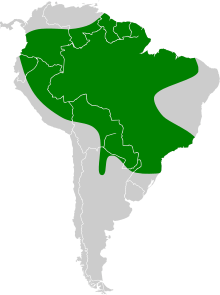Cinnamon dog-faced bat
The cinnamon dog-faced bat (Cynomops abrasus), is a South American bat species of the family Molossidae.[2] It is found in northern and central South America.[1]
| Cinnamon dog-faced bat | |
|---|---|
 | |
| Preserved specimen in the Naturalis Biodiversity Center | |
| Scientific classification | |
| Kingdom: | Animalia |
| Phylum: | Chordata |
| Class: | Mammalia |
| Order: | Chiroptera |
| Family: | Molossidae |
| Genus: | Cynomops |
| Species: | C. abrasus |
| Binomial name | |
| Cynomops abrasus Temminck, 1827 | |
 | |
Taxonomy
The bat belongs to the genus Cynomops, which was recently split from the genus Molossops.
There are 4 subspecies of this bat:
Description
The dorsal fur is brown, dark brown or chestnut. The ventral fur is similar in color to the dorsal fur. A dense patch of fur is present on the wing, located on the top back third of the forearm and propatgial membrane. There is also a second patch of fur on the bottom, back three-quarters of the forearm that extends across the patagium near the wrist to the base of the fourth metacarpal. These patches are darker in color than the membrane.
The bats have a broad face with widely separated ears. There are no wrinkles on the lips. There is also no nose leaf present. The bats display sexual dimorphism. The average total length is 121.1 mm (4.77 in) and the average tail length is 37.6 mm (1.48 in). The forearm length in males is 44.2–49.0 mm (1.74–1.93 in) and in females it is 41.0–45.0 mm (1.61–1.77 in). The greatest skull length is 19.5–24.3 mm (0.77–0.96 in) in males and 18.4–21.5 mm (0.72–0.85 in) in females.[4]
Biology
The bat is insectivorous. They typically feed on hard-shelled insects.[1]
Habitat and distribution
The species is found on the eastern side of the Andes in northern Argentina, Bolivia, Brazil, Colombia, Ecuador, French Guiana, Guyana, Peru, Paraguay, Suriname and Venezuela. The bat is an open-air hunter and is limited to forests. It is found in high and dense forests in Argentina and near floodable lands in Paraguay.
The bat roosts in colonies of up to 75 individuals. The bat roosts in decayed logs and hollow trees, and tends to pick relatively warm area to roost.[1][4]
Conservation
The bat is listed as data-deficient by the IUCN because of a paucity of records of the bat and the lack of knowledge about its habitat and status.
The species could be threatened by deforestation occurring in its range.[1]
References
- Barquez, R.; Diaz, M. (2016). "Cynomops abrasus". IUCN Red List of Threatened Species. 2016: e.T13637A22109417. Retrieved 22 March 2020.(previous version)
- Simmons, N.B. (2005). "Order Chiroptera". In Wilson, D.E.; Reeder, D.M (eds.). Mammal Species of the World: A Taxonomic and Geographic Reference (3rd ed.). Johns Hopkins University Press. p. 436. ISBN 978-0-8018-8221-0. OCLC 62265494.
- "ITIS Standard Report Page: Cynomops abrasus". www.itis.gov. Retrieved 2020-03-21.
- "Molossops abrasus - Vertebrate Collection | UWSP". www.uwsp.edu. Retrieved 2020-03-21.
- Eger, Judith L. (1 March 2008). Gardner, Alfred L. (ed.). Mammals of South America, Volume 1: Marsupials, Xenarthrans, Shrews, and Bats. University of Chicago Press. pp. 403–404. ISBN 978-0-226-28240-4. OCLC 644361912.
